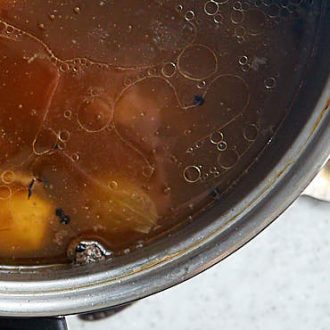A beef broth will have a more distinct beefy flavor from the meat. Traditionally, beef stock, due to its more neutral taste, is used as a base for many sauces and soups. A broth, on the other hand, is a great choice for soups or dishes that required a strong and distinct beef flavor.
Types of beef stock
Beef stock is typically divided into two categories: white beef stock and brown beef stock. White beef stock is made from beef or veal bones, or a combination of the two. Brown beef stock is made from beef and/or veal bones that have been browned in an oven or in a pan.
Beef stock ingredients
Bones
When certain connective tissues (called collagen) break down, they form gelatin. This gives a stock it’s thick body, an important indication of a stocks’s quality. A well-made stock thickens or even becomes solid when chilled. Cartilage is the best source of gelatin in bones. Younger animals have lots of cartilage in their skeletons. As they become older, this hardens into solid bone, which is harder to dissolve into stocks. Knuckle bones, on the joints of major bones, have a lot of cartilage and are most often preferred for stock-making. Neck bones and shank bones are also often used. Large bones need to be cut into 3-4-inch pieces for better handling and better extraction.
Mirepoix
Aromatic vegetables are the second most important contributors of flavor to stocks, after bones and meat. Mirepoix today refers to a combination of onions, carrots, and celery. It is a basic flavoring in many areas of cooking and not only for flavoring stocks. The traditional mirepoix in the past would contain a wider variety of ingredients, including ham or bacon, leeks and other vegetables, and one or more fresh herbs. The modern version is considerably simplified but you should feel free to add more ingredients as desired. A white mirepoix, in which parsnips are substituted for carrots, can be used when it is necessary to keep the stock as colorless as possible, usually when making white beef stock. When making white mirepoix, celery root can be substituted for the stalk celery for an even whiter mirepoix. It’s also a good idea to include leeks in the mirepoix in place of part of the onions in a white mirepoix for their flavor.
Acidic ingredients
Acids help dissolve connective tissues and so are a great addition when making beef stock. Tomatos and tomato products contribute flavor and some acid to brown stocks, though in small quantities as they may make a stock cloudy. When making white beef stocks tomato products are not included due to their color.
Seasonings and spices
Salt is usually not added when making stocks. That’s because stocks are often reduced, concentrated, and combined with other ingredients. If salt were added, it might become too concentrated. Some chefs do salt stocks very lightly though because they feel it aids in extracting flavor. Herbs and spices are used very lightly ans they should never dominate a beef stock, or have a pronounced flavor. Traditionally, herbs and spices would be tied in a cheesecloth bag called a ‘sachet d’épices’ which can be removed easily at any time. A ‘bouquet garni’ is also often used when making stocks, which is an assortment of fresh herbs and other aromatic ingredients tied in a bundle with string. A basic ‘bouquet garni’ consists of pieces of leek and celery, thyme sprigs, bay leaf, and parsley stems. Another ingredient commonly used for stock flavoring is burnt onion.
Procedure for preparing basic white beef stock
Procedure for preparing basic brown beef stock

